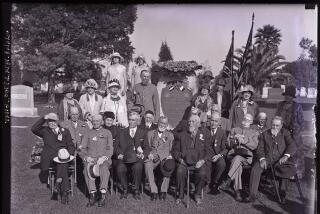Bloody Civil War Clash Site of New Battle--Over Development
- Share via
SHARPSBURG, Md. — It was 125 years ago that the blue and the gray marched across South Mountain and engaged in the Battle of Antietam, the bloodiest single day in the Civil War.
Today, developers are approaching that ridge in western Maryland, threatening to spoil one of the best-preserved Civil War battlefields in the East.
“South Mountain has been a natural ally with the battlefield in keeping development out,” says Dennis Frye, president of the Save Historic Antietam Foundation Inc. “But it’s creeping around the mountain and that’s a dangerous omen.”
The Battle of Antietam began at dawn on Sept. 17, 1862, on 7,000 hilly acres along the Potomac River about 60 miles northwest of Washington. When the smoke cleared, more than 23,000 Union and Confederate soldiers were dead, wounded or missing.
Development Moving West
As the battlefield commemorates its 125th anniversary, urban development is moving west from the Baltimore and Washington areas into the Antietam Valley.
“This is an issue of national ramifications,” Frye says. “We are talking about bulldozing our battlefields and I don’t want the responsibility on my shoulders of watching this generation destroy our Civil War history. Americans stained the battlefield there with their blood.
“There must be a compromise between developers and preservationists. We are not opposed to development, but we don’t want Sharpsburg to become another commercial Gettysburg.”
The National Park Service owns about 800 acres outright and controls another 1,200 acres in easements, Frye says. Although just 2,000 acres of the 7,000-acre historic battlefield are protected, a lack of development has helped keep it well-preserved.
“The opposite of it is Gettysburg,” says Roger Long, associate editor of Blue & Gray Magazine, based in Columbus, Ohio. “They have absolutely sold it to the highest bidder. Everybody’s heard of Gettysburg, but not everybody has heard of Antietam, yet it was the single bloodiest day.
‘It’s Kinda Spooky’
“I have been all alone at Antietam. I’ve walked up the Bloody Lane where there were bodies stacked so you could walk and never touch the ground. It’s kinda spooky. I don’t think you could ever do that at Gettysburg no matter what time of the day or what time of the year you were there.”
Besides having South Mountain as a natural barrier to development from the east, farmers who own land surrounding the Antietam battlefield have not sold their property to developers. They h1635149088the farms from one generation to another. The farms are still farms and the fences are still where they were 125 years ago.
One park ranger remarked that, if they could come back, the soldiers would recognize the exact spot where they fought.
Development also has been limited because the 800 residents of nearby Sharpsburg have not tried to cater to the thousands of Civil War buffs and tourists who visit Antietam every year.
Tourism officials say more than 600,000 people visit the battlefield annually, but, says Sharpsburg Mayor Gerald Quinn, “in all honesty, we don’t see them.”
‘No Reason’ for Tourists
“Because we haven’t aimed business at them, there is no reason for them to come into town,” he says.
Not so at Gettysburg, about 50 miles north of Antietam.
On July 3, 1863, in a last-ditch effort to break the center of the Union lines at Gettysburg, Confederate Gen. Robert E. Lee ordered 15,000 men, under Gen. George E. Pickett, to charge the Union ranks. When Pickett’s charge failed, the Confederate Army was forced to end its 1863 invasion of the North and withdraw into Virginia.
Today, the site of the northern end of Pickett’s charge is heavily developed.
“There’s block after block of fast-food restaurants, souvenir shops and motels,” Frye says. “It has been completely destroyed. Nobody raised their voices in alarm in Gettysburg and, as a result, it is one of our most blanket disasters in terms of historic preservation.”
Bob Davidson, assistant superintendent of Gettysburg National Military Park, says it’s hard to compare the two sites because Gettysburg has always been situated in a more densely populated area.
Concern About Gettysburg
“I’m afraid it’s too late to turn back the clock on Gettysburg, but the park continues to express concern about how development takes place,” Davidson says. “There has been some progress.”
Could Antietam could end up looking like Gettysburg?
In 1985, a shopping center was proposed on the Grove farm outside the park service’s boundaries. The Washington County commissioners rezoned 20 acres of the 120-acre historic tract, just south of Sharpsburg, for commercial use.
The rezoning alarmed preservationists.
The Grove farm was the backdrop of famous photographs taken when President Abraham Lincoln traveled to the Antietam battlefield to confer with Union commander George B. McClellan. The farm also served as a field hospital for soldiers from the North and South.
“We felt the area deserved more than asphalt parking lots, neon signs and souvenir trinket shops,” Frye says.
Preservationists collected 5,000 signatures in 30 days through Civil War Roundtables across the United States and after various court battles the rezoning was found to be null and void. The issue was appealed, however, and the Maryland Court of Special Appeals ruled that three properties next to the farm, including a 12-acre tract targeted for a shopping center, were legally rezoned in 1985 from agricultural and conservation to commercial.
Other Zoning Battles
Meanwhile, the Save Historic Antietam Foundation has continued to fight other zoning battles. Also, the state recently gave $50,000 to the county, which has set up a special committee to study preservation around the battlefield.
More to Read
Sign up for Essential California
The most important California stories and recommendations in your inbox every morning.
You may occasionally receive promotional content from the Los Angeles Times.










